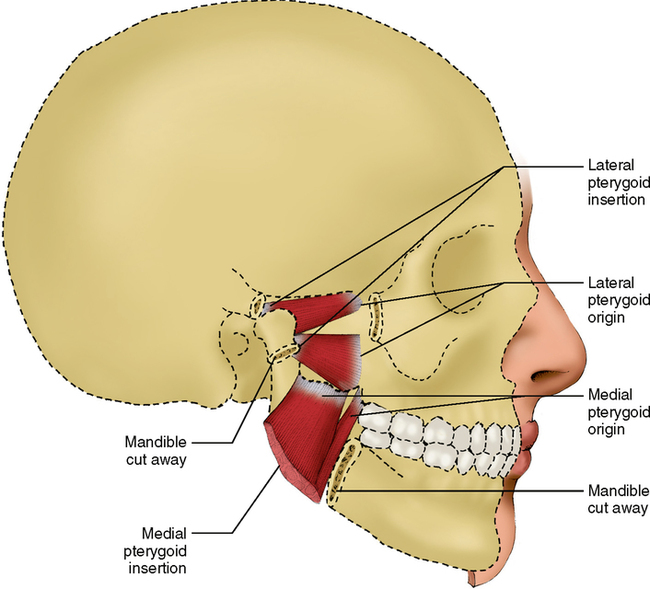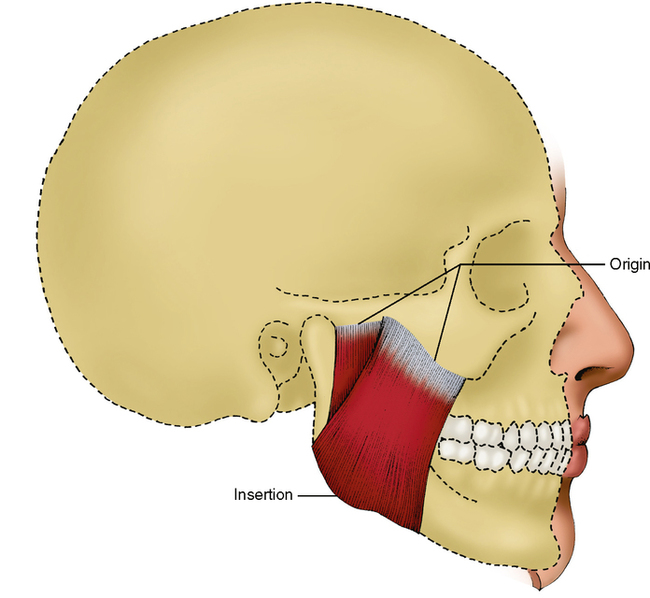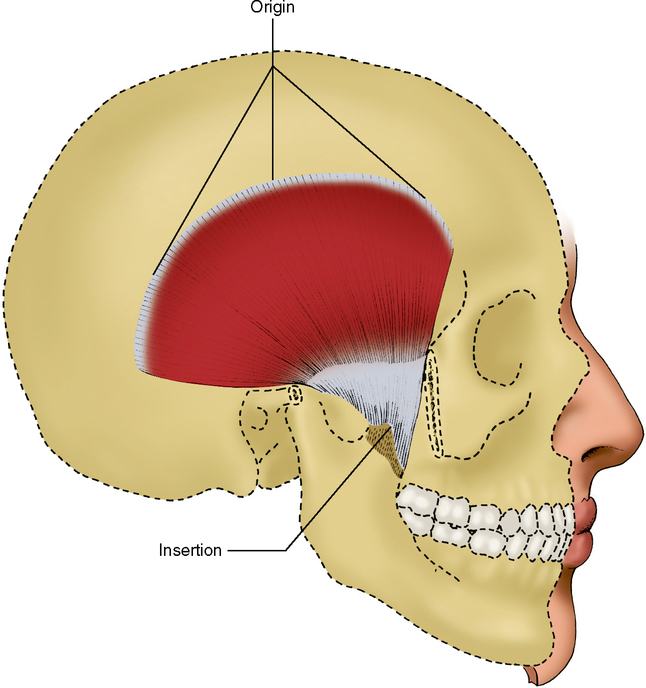Muscles of Mastication, Hyoid Muscles, and Sternocleidomastoid and Trapezius Muscles
• To describe the origin, insertion, action, and nerve and blood supply of the muscles of mastication
• To categorize the muscles according to their roles in elevation, depression, protrusion, retrusion, and lateral excursion of the mandible
• To describe the functions of the sternocleidomastoid and trapezius muscles and their roles in referred pain to various areas, including the temporomandibular joint
• To name the suprahyoid and infrahyoid muscles and their roles in mandibular movement, swallowing, and phonation
MUSCLES OF MASTICATION
The muscles of mastication are four pairs of muscles attached to the mandible and primarily responsible for elevating, protruding, retruding, or causing the mandible to move laterally. They develop from the first (mandibular) pharyngeal arch, which is also responsible for the development of some of the bony facial structures. Because they develop from this arch, they are innervated by the nerve of the first arch, the fifth cranial nerve (trigeminal nerve). More specifically, the muscles are innervated by the third part of the fifth nerve, which is called the mandibular division or V3. The blood supply to these muscles comes from the maxillary artery, which is a branch of the external carotid artery. Blood vessels and nerves are further discussed in Chapters 32 and 34.
Masseter Muscle
The masseter muscle is probably the most powerful of the muscles of mastication. It takes its origin from two areas on the zygomatic arch. The superficial head originates from the inferior border of the anterior two thirds of the zygomatic arch. The deep head arises from the inferior border of the posterior third of the zygomatic arch and the entire medial side of the zygomatic arch. The fibers of the superficial head run down and slightly back to be inserted into the angle of the mandible on the lateral side. The deep head has vertically oriented fibers. When the masseter muscle contracts, it elevates the mandible, closing the mouth (Fig. 28-1).
Temporal Muscle
The temporal muscle, frequently called the temporalis muscle, has a very wide origin from the entire temporal fossa and the fascia covering the muscle. The anterior fibers run almost vertically, but the posterior fibers run in a more horizontal direction over the ear. All these fibers insert into the coronoid process of the mandible and sometimes run down the anterior border of the ramus of the mandible as far as the third molar (Fig. 28-2). If the entire muscle contracts, the overall action pulls up on the coronoid process and elevates the mandible, closing the mouth. If only the posterior fibers are contracted, the result is a horizontal pulling of the coronoid process in a posterior direction. This pulls the mandible backward, which is referred to as retruding the mandible.
Medial Pterygoid Muscle
In studying the origin of the medial pterygoid muscle, it is probably best to examine a model of the skull while reading the description. The muscle has two origins. The larger and major origin is from the medial side of the lateral pterygoid plate and the pterygoid fossa as well as a tiny area of the palatine bone at the lower end of the medial and lateral pterygoid plates. This area is called the pyramidal process of the palatine bone. The smaller origin is just anterior to that area, coming from the maxillary tuberosity just behind the third molar. All the fibers run down and slightly posteriorly and laterally to be inserted into the angle of the mandible on the medial side. This is just opposite the masseter insertion on the lateral side. When the muscle contracts, the resulting action is elevation of the mandible and closing of the mouth (Fig. 28-3).

Lateral Pterygoid Muscle
The lateral pterygoid muscle also has two separate origins. The smaller, superior origin or head arises from the area called the infratemporal crest of the greater wing of the sphenoid bone. The larger, inferior origin or head arises from the lateral side of the lateral pterygoid plate. This is just opposite the origin of the medial pterygoid muscle. The fibers from both origins of the lateral pterygoid muscle run horizontally in a posterior direction. Some fibers from the superior head penetrate the capsule of the temporomandibular joint (TMJ) and insert into the anterior border of the disc of the joint. The remainder of the fibers from that origin and the fibers of the inferior head insert into the neck of the condyle on the anterior and medial side (see Fig. 28-3).
The lateral pterygoid muscle has several actions. The inferior head pulls the condyle forward and helps protrude and depress the mandible. The disc is also brought forward because of its attachment to the condyle. When both left and right inferior heads function, the mandible is protruded and depressed. If only one lateral pterygoid is contracted, there will be lateral excursion to the opposite side of the contracted muscle. The superior head of the lateral pterygoid functions primarily in the action of biting or what is sometimes called the power stroke. It functions to guide the posterior movement of the disc and condyle as it goes back to a centric position. In other words, as other muscles are pulling posteriorly, the upper head of the lateral pterygoid is relaxing and controlling that movement (see Fig. 28-3).
Stay updated, free dental videos. Join our Telegram channel

VIDEdental - Online dental courses




